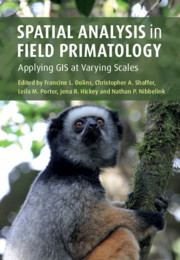Book contents
- Spatial Analysis in Field Primatology
- Spatial Analysis in Field Primatology
- Copyright page
- Dedication
- Contents
- Contributors
- Acknowledgments
- 1 Why Place Matters, and its Use in Primate Behavioral and Ecological Research
- Part I GPS for Primatologists
- Introduction
- 2 Fundamentals of GIS and GPS
- 3 “Next-Gen” Tracking in Primatology
- 4 The Ethical Implications, and Practical Consequences, of Attaching Remote Telemetry Apparatus to Macaques
- 5 Processing Geospatial Data in R
- 6 Estimating Travel Distance and Linearity of Primate Routes
- Part II GIS Analysis in Fine-Scale Space
- Part III GIS Analysis in Broad-Scale Space
- Index
- Plate Section (PDF Only)
- References
Introduction
from Part I - GPS for Primatologists
Published online by Cambridge University Press: 29 January 2021
- Spatial Analysis in Field Primatology
- Spatial Analysis in Field Primatology
- Copyright page
- Dedication
- Contents
- Contributors
- Acknowledgments
- 1 Why Place Matters, and its Use in Primate Behavioral and Ecological Research
- Part I GPS for Primatologists
- Introduction
- 2 Fundamentals of GIS and GPS
- 3 “Next-Gen” Tracking in Primatology
- 4 The Ethical Implications, and Practical Consequences, of Attaching Remote Telemetry Apparatus to Macaques
- 5 Processing Geospatial Data in R
- 6 Estimating Travel Distance and Linearity of Primate Routes
- Part II GIS Analysis in Fine-Scale Space
- Part III GIS Analysis in Broad-Scale Space
- Index
- Plate Section (PDF Only)
- References
Summary
Over the last two decades, technological advances in GPS (global positioning devices) and GIS (global information systems) have allowed primatologists to dramatically increase the quantity of spatial location data they can gather in the field, and the complexity of the analyses they can perform on these data. Prior to 15 years ago, GPS units did not function well in remote locations and/or under dense foliage, thus they were useless for most field primatologists. In contrast, in the last 15 years, technological advances have made GPS devices functional across the globe and in most environments, allowing field researchers to collect detailed spatial data using this technology. In addition, increased access to and development of GIS software has allowed primatologists around the world to perform complex analyses of these data.
- Type
- Chapter
- Information
- Spatial Analysis in Field PrimatologyApplying GIS at Varying Scales, pp. 9 - 13Publisher: Cambridge University PressPrint publication year: 2021



